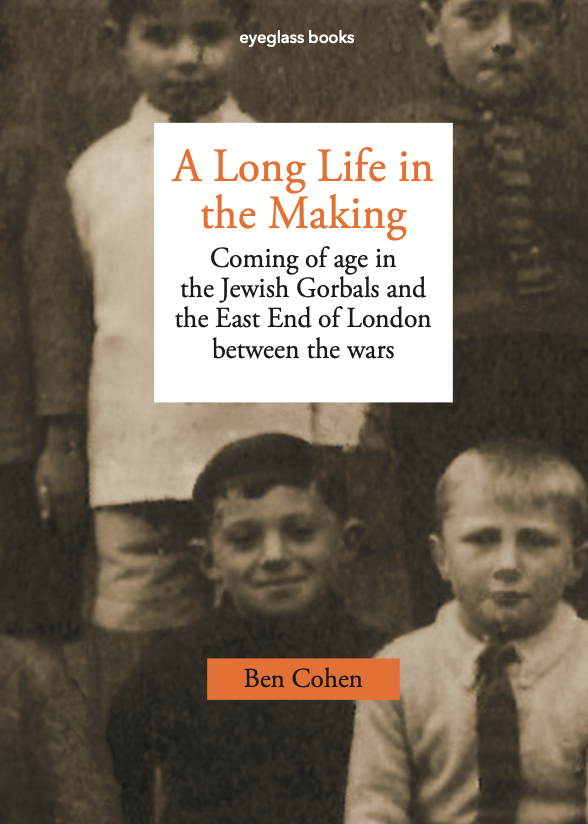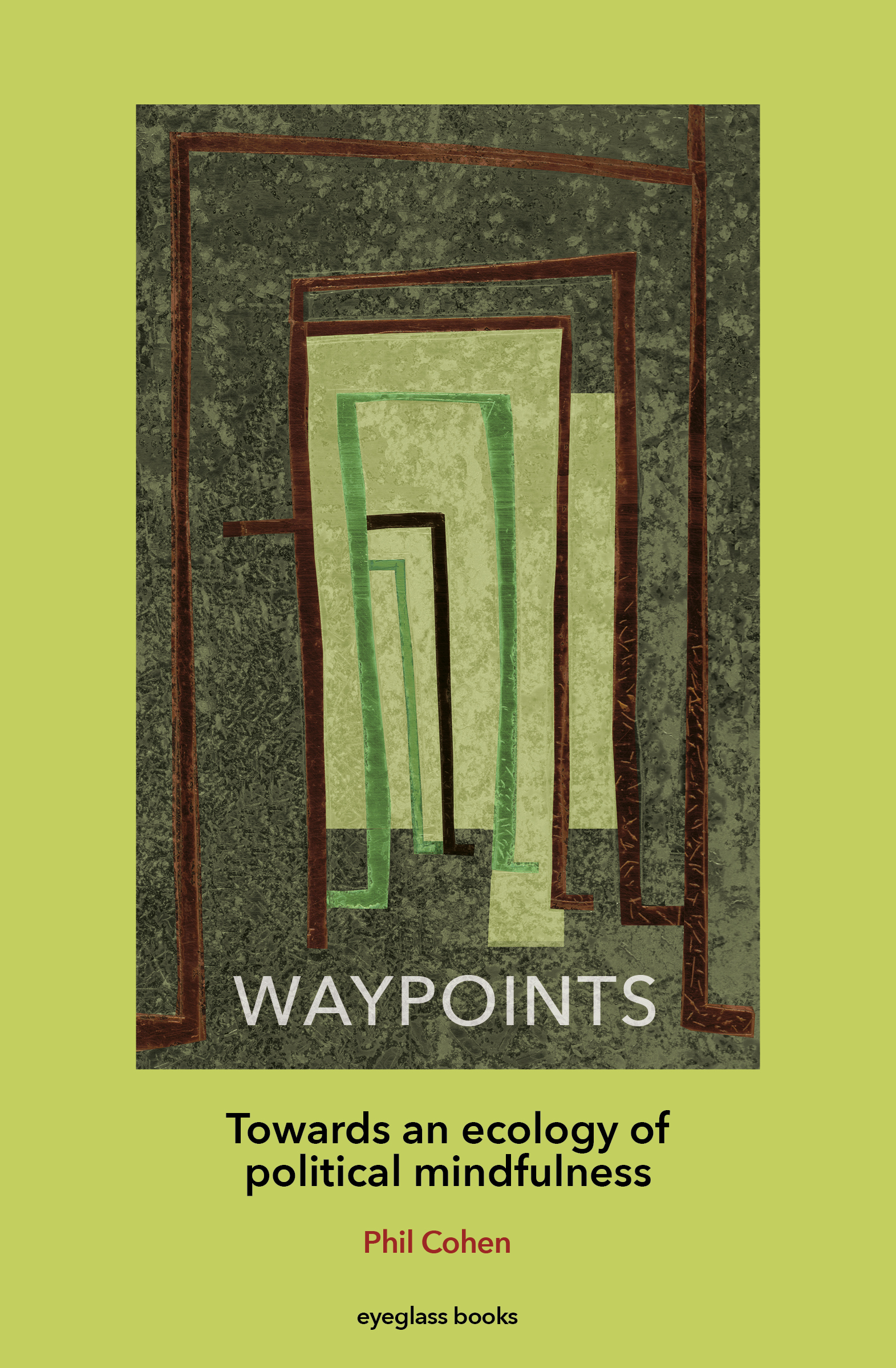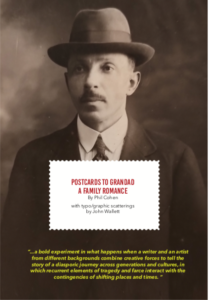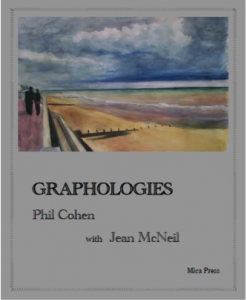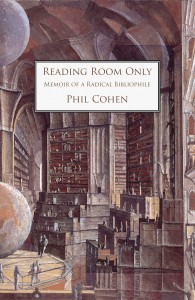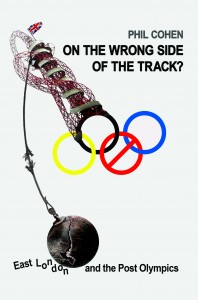The Triple Misalliance
I
An extract from‘Studies in thr Grey Zone; Waypoints Vol 2 to be published by eyglass books at Easter 2024
.Introduction
One of the many fallouts from the current horrific conflict in Palestine/Israel is the way sections of the Hard Left have advanced an apologetics for the atrocities committed by Hamas, while ignoring or downplaying the reactionary character of its political culture and simultaneously highlighting the colonialist roots of the Zionist project and the genocidal impact of Israel’s policies towards the displaced Palestinian populations of Gaza and the West bank.
One of the more bizarre aspects of this double standard, has been a debate on the Anti-Racist Left in Britain about whether or not Jews can be regarded as white’ . Can they legitimately be regarded as an oppressed minority ? If the answer in both cases is no then the argument goes, they cannot be said to suffer from institutionalised forms of racial or ethnic discrimination , even if they are subject to Judaeo-phobic prejudice ., It is then further claimed that the Jewish diasporic community in Britain now belongs within a white power structure which has long oppressed people of colour and continues to do so. Not surprisingly this argument comes from a section of the Left that has historically regarded the Jewish community with the greatest suspicion , on account of some of their members’ involvement in c commercial and financial activities and notwithstanding the role which Jewish intellectuals and workers have played in socialist and radical politics .
The short essay that follows was originally written in 1995 ,and came out of an antiracist education and research project which I carried out in the Isle of Dogs in the East End of London . This work tool place at a time when the Bangladeshi community, which had replaced the Jewish community in Whitechapel and surrounding areas , had come under vicious attack from the same sections of the Far Right which had marched with Mosely in the 1930’s and been stopped at the battle of Cable Street. This shared history gave me pause for thought concerning the local roots of both Antisemitism and Islamophobia. Given the currently polarized views towards the Palestinian and Jewish Questions on the left , I thought it might be useful to give the essay, originally published as ‘The Other East’ in Demos 8 199 5 . another airing. I have reproduced the original text with some updates and revisions, and added a final section looking at the development of orientalist perspectives within Zionism itself. I am very grateful for the useful comments of many friends, both Jewish and non- Jewish, with whom I have discussed these issues over the past two months. None of them should be held responsible for the views expressed here.
The same old East End Story?
In comparing and contrasting the public discourses of anti-semitism and orientalism and their associated image repertoires , we need to be aware of the full range of variations in the multiple voices and registers through which they have been expressed. One aspect of this which is often neglected is the local context in which these images and discourses circulate , and their meanings taken on specific resonance. We need to know more about these situated meanings , the timing and placing of the tropes by which Jews are orientalised, and/or Arabs figured in what antisemitism has made out of the Jew. This is not just a question of how racialised images are attached conjuncturally and opportunistically to certain discourses of the body politic and who does or doesn’t belong within it ; it is about how these representations coalesce, principally through networks of rumour ,gossip and moral panic to fashion cultural geographies of exclusion that are operative at the level of the neighbourhood, the school, and access to local amenity . The specific urban or rural location of Jewish and Arab communities , and whether or not they directly interface within the same area has a direct bearing on how they are depicted in the mental maps that are drawn of nations, cities, neighbourhoods, schools, and all the institutions of civil society.
It is not just populations that are orientalised or semitised, but the areas where they live. By the bias of specific habits and habitats that come to be associated with certain racial or ethnic attributes , we talk about a Jewish quarter, or an Arab quarter, a black area or a white area, as if there was a direct relation between the critical mass of representations and the demographic profile of the inhabitants. But of course there rarely is. One effect of this kind of ethno-cartography is to create a fictive concord between peoples and places – so we talk about a Jewish quarter even though there may well be a larger number of non Jews living there. For example Finchley is widely regarded today as a ‘Jewish area’ but the majority of the population is in fact not Jewish , and it contains many other ethnic minorities , some of whom of course are Muslims . The mass media , both locally and nationally , play a big part in this urban imagineering of race by giving particular areas reputational identities for being ethnic ghettoes or racial front lines ,in a way that air brushes out of the picture anyone or anything that suggests otherwise.
The second preliminary point concerns the relation between internal and external colonialism. For a long time in the UK it did not seem possible to integrate the analysis of the local history of antisemitism into a discussion about Orientalism – because Orientalism was clearly part of British colonial racism and hence a hegemonic instance of its domestic form – whereas antisemitism was not part of this history and was therefor seen as a subordinate instance- the ‘other racism’ But with the development of the analysis of internal colonialism a different perspective opened up. Initially the study of internal colonialism was confined to the historical study of what was called the British empire in Europe – the forms of ethnic hegemony exercise by the English over the Welsh, Scots and especially the Irish in creating that locally imperial anglophonic archipelago known as the British Isles or sometimes the United Kingdom. But more recently we have come to see that this process of internal English colonialism also involves Europe’s internal others – Gypsies, Slavs, and above all Jews. The Jewish presence in Britain is the presence of the European Other in a double sense – the presence of European culture and ideas – especially political ideas- that threaten the cultural insularities of the English as an island race and of Britain as an island home – and, secondly, the Other who comes from the East – Eastern Europe of course but also – and this is the link with Orientalism and external colonialism – from the eastern Mediterranean
Orientalism’s Other Scenes
Now I want to bring these two points together to consider why and how the Jewish immigrants to the East end of London in the late Victorian and Edwardian periods were portrayed as Orientals . The growth of antisemitism during this period is well documented but it largely focuses on the creation of popular physico-moral stereotypes – the hooked nose, the grasping hands, and the bent back signifying duplicity and greed -to be found in cartoons a and postcards , as well as the narrativization of these features in popular fiction. There were also, of course the practical measures of exclusion and discrimination to which the inhabitants of the Whitechapel ‘shtetl’ were subjected, not least by the local labour movement. However . at first sightt there seems to no direct material link between this history of popular antisemitism and the colonial imagination of East London as a ‘dark continent’ where the erstwhile subjects of Empire might just possibly strike back. Yet it is possible to find such links hiding in the light that can be thrown of both by a more locally situated reading (1).
I first became aware of these symbolic links in the 1980’s and 90’s when I was carrying out ethnographic research into playground cultures in East London. This was a period in which the Jewish population had been largely replaced by new immigrants from Bangladesh , and by an influx of Vietnamese Chinese refugees, as well as by people from an African or Afro-Caribbean background . Our research also coincided with the release of the Indiana Jones series of films which powerfully renewed Orientalist themes prevalent in the popular culture of Imperialism in Edwardian times. We discovered that traditional constructions of the Orient as a mysterious (female) and despotic (male) continent continued to provide the mise en scene for many of the childrens’; fantasy games (2). Especially around the time of the Western intervention against Saddam Hussein, children drew heavily on such themes to re-stage scenarios of the Gulf war in terms of a more local geopolitics of ‘race’. White English and Afro-caribbean children teamed up to go on ‘peace keeping missions’ in which they pushed Bangladeshis, Vietnamese/Chinese and other Asian children into ‘sin bins’. But that was not always the end of the story; in one playground we studied the ‘Indiana Jones’ role was actually played by a Moroccan Jewish boy who rallied his forces and chased the ;’guards’ away so as to rescue the hostages from the sin bin.
There was clearly more going on here than a simple reproduction of a culture of imperialism. There was perhaps another history of Orientalism at work , one bound up with a more local and internal presence than the instances analyzed by Edward Said in his classic study (3). In fact ,the occidentalist project, the opposition between a Civilised/Christian West and Barbarian/Sybaritic l East has been as much played out within the cultural geography of Europe itself, as in the colonial context. From the middle ages on, it has been mobilised to define and marginalise Europe’s internal Others (4). Whatever their actual origins, or location Jews, Gypsies and Slavs were frequently invested with an ‘oriental’ character in the discourses which defined the historical mission of ‘the West’ at the leading edge/ guardian of Reason, Enlightenment and scientific progress. During the Cold War the Communist East inherited the mantle of Europe’s Other Within , and then with the fall of the Berlin Wall, the Ossies found themselves placed alongside Turkish guest workers in a position of generic inferiority vis a vis the Wessies as the standard bearers of advanced capitalism.
The notion of the West as a citadel of Culture and Modernity, threatened with invasion from a dangerous and degenerate East had also been a well rehearsed theme in the history of London . From the early Victorian period the development of the metropolis was a tale of two cities which was also two nations- of inherited wealth and congenital poverty (5). As the same time the contrast between West End and East End took on another set of meanings to do with Race and Empire. The Victorian urban explorers frequently used racial imagery to define the ‘natives’ of the east end as primitives, or barbarians; and this iconography was applied to local colonies of Chinese, Malays, and Africans in docklands areas , and then,in turn , to Jewish immigrants from Eastern Europe. As a result the non-christian, non occidental character of the area became a topic of increasing public concern (6). Just as the West End was sharpening its image as the glittering cosmopolitan hub of worldwide Empire, so it was felt to be increasingly menaced by the East End as a kind of Internal Orient, a mysterious continent whose dense localisms formed the heart of the Other England,.
The first cartographer of this internal orient was Thomas De Quincey. In The Confessions of an English Opium Eater he discusses his experiences with the ‘oriental drug ‘ and his explorations as an East End flaneur in almost identical terms. His dreams are crowded with turbulent processions of Chinese and Malays, in street bazaars where he is forever lost and wandering in search of forbidden pleasures, pursued by the monstrous fauna and flora of the Ganges and the Nile. Then he describes himself walking in an East En street:
‘Surrounded on all sides with a sea of myriad shapes in which everything fluctuates as I seek to find an individual human face ‘within the indistinguishable mass of this surplus population so reminiscent of the swarming continent of Asia.’
De Quincey also observes in the language and gestures of these East Enders ‘the subtle signs of subversion, the Jacobin influence’. He is both fascinated by the promiscuity of the urban crowd and fears its powers of social contagion and combination, and he locates both in an imaginary geography where the East represent what he calls the barbaresque – the negation of everything that the West stands for.
A hundred years later Kipling followed in De Quincey’s footsteps in making the connection between the external and internal orient. In The Great Amulet his Sikh prince is made to submit to Western education with ‘all the deceptive compliance of the oriental’, but only in order to stab his benefactors in the back. The heroine of the story is described as ‘the epitome of the heart of India , aloof , illogical,long suffering, sensual, to a degree unimaginable to the Western mind’.A few years later Kipling wrote a another story, this time about a coster girl from Bethnal Green , in which he describes her character and culture in almost identical terms. In doing so he was conforming his story to a genre of writing about the East End in which the population is characterised as belonging to a race apart from the rest of society, one whose habits and habitats had first to be explored, and then civilised, after the manner of India, or Africa.
A key feature of this discourse was the image of the turbulence associated with the multiracial diversity of the East End and the need to submit it to some kind of urban industrial discipline. Charles Booth in his famous study of East London Life and Labour saw the issue in Darwinian terms :
” a clash of contest, man against man, and men against fate, the absorbing interest of a battlefield a rush of human life as fascinating to watch as the current of a river. And looked at this way , what a draw it is. Whitechapel is a tom tiddlers ground, the eldorado of the east , a gathering together of poor fortune seekers, its streets are full of buying and selling, the poor living on the poor.”
This melodrama might however be staged in more benign fashion as a harmless pageant celebrating multicultural difference:
“There one sees all nationalities. A grinning hottentot elbows his way through a crowd of long legged Jewesses. An Algerian merchant walks arm in arm with a native of Calctta. A little Italian plays pitch and toss with a small Russian. A polish Jew enjoys sauerkraut with a German gentile. And amongst the foreigners lounges the East End loafer, monarch of all he surveys, lord of the premises.”
This relaxed scene is however made entirely dependent on the presence of the native East Ender who is shown imagining himself as a cross between a local colonial administrator and urban squire providing a framework of supervision within which his different subjects can happily co-exist.
But what happens when this imperial figure is removed ? Olive Malvery, an Anglo Indian observer of the area , and a devout believer in the superiority of the English way of life has this to say in her book Soul Market:
There are some localities in London which are almost entirely foreign; indeed some places are so alien in their characteristics that one might fancy oneself in another country on entering them.Today the Brick Lane end of Wentworth street Whitechapel is one of the most unEnglish spots in the British Isles. Whichever way one turns one sees nothing but foreign figures and hears nothing but foreign tongues.Here stands a bearded Jew with the face and figure of a raphael cartoon;there is a woman selling lemons; her shawl enwraps the face of a Botticelli Madonna. Thick lipped Fagins and grey haired philosophers, pretty faces and hooked nose ugliness; nowhere perhaps in the whole of england can one see so varied or picturesque a crowd.”
As long as these figures can be Europeanised in some way they remain merely picturesque, but hooked noses and thick lips are clearly the sign of difference which cannot be assimilated. And where now is the figure in the landscape who is the uncrowned monarch of all he or she surveys? She leaves the reader in little doubt:
Every house in the street is a shop and in every shop there is a Jew. The walls of the houses are covered with Hebraic or Yiddish placards. The original inhabitants have all been crowded out . .. there is little difficulty in recognising the influence that immigrants from these places ( in Europe) have had on the submerged population of our great cities. Here is yet one more example of the cruel and wicked fashion of crushing out everything that is british and encouraging everything that is foreign.
As John Barrell shows in his important study (7),De Quincey’s fear of being “contaminated” by physical or social contact with the barbaresque was also an important theme in his antisemitism. In one notorious passage he writes of:
“men’s natural abhorrence of the Jewish taint, as once in Jerusalem they had hated the leprosy and cholera (oriental diseases), because even while they raved against it the secret proofs of it could be detected amongst their own kindred”.
In the portrayal of the East End as a centre of foreign immigration and cultural diversity, Antisemitism and Orientalism increasingly converged in constructing an alien threat which is both global in scope and intensely local in effect .In the process Jews are increasingly confused with ‘Orientals’. For example one of the witnesses from a local community settlement cross-examined during the police enquiry into the Jack the Ripper murders described living conditions in the Jewish quarters in the following terms:
“There is something of the Oriental bazaar about the Jewish market, the swarms of unkempt children running hither and thither on countless errands, the women haggling with each other, shouting to make themselves heard over the general hubbub, the men scurrying in and out of dark alleyways, the whole effect is one of labyrinthine confusion which can scarcely fail to make a fearful impression on the casual visitor.”
In the sober deliberations from the House of Commons Select Committee on Housing in 1901 we find the following exchange:
Lord Robert Cecil: What do you say about the inhabitants ?
Lord Lupton: Most of the inhabitants are Jews and their habits are said to be clean so far as their persons go, but certainly the courts outside their houses are….
Lord Robert Cecil: Eastern in character?
Lord Lupton : Yes that is so exactly.
The Jews referred to were of course Ashkenazim from the shtetls of Eastern Europe, not Sephardis from North Africa or the Middle East, but this conflation is entirely characteristic of both popular and official perceptions of the period.
At the same time moral panics around drugs and sexuality which became focused on the Chinese community of Limehouse included many features borrowed from antisemitism. As Marek Kohn has shown(8) the theme of a criminal underworld organised by a secret oriental conspiracy, which was popularised by Sax Rohmer in his Fu Manchu novels, owed much of its logic to the Protocols of the Elders of Zion. Another point of convergence was the so called ‘white slave trade’. If Opium was a medium of seduction of white women by ‘men of colour’ , their induction into oriental perversity was supposed to lead inexorably to their final falling into the hands of Jewish pimps who shipped them out to the brothels of Latin America or the middle east . Note how once against Jews are here located as ‘non white’ and ‘eqipped with oriental features. At the same time the derogatory epithet of ‘street arab’ was applied indiscriminately to children of the ‘criminal and perishing classes ; whose dirty unkempt appearence belied their white skins .
In this strange cultural geography regions that were elsewhere referred to as being in The Middle East, or the Far East , were collapsed into the Generic Oriental, and those who lived there , whatever their actual location or ethnicities, Jews and Muslim , Arabs, Chinese , Japanese and Indians , all found themselves inhabiting the same bizarre country of the European mind(9). For example in the image repertoires of Edwardian postcards – and lets remember these were the texting platforms of everyday communication in this period- both the Asian and Jewish communities are often portrayed in very similar terms , as being ‘two faced’ ; the outward appearance of respectability and even prosperity being only a cloak for hidden cruelty or corruption undermining both family and nation. . Jewish Money allied to Oriental Vice was imagined as a hidden artery linking the East End of London with the West End, directly injecting moral infection into the civilized heart of metropolis and Empire.
So although the culture of imperialism and its legacy did not direct implicate those Jewish immigrants and refugees fleeing pogroms in Russia and Eastern Europe , it was through the devious relays I have described that their fate was to become entangled in it. This close articulation of Orientalism and Antisemitism was an important element in the formation of the East End’s popular culture of racism, and, equally its complicated forms of internal resistance .
I was reminded of this latter aspect by a story told me by a Jewish woman who used to live in Whitechapel. She remembered that when Mosely’s Blackshirts tried to march down Brick Lane in 1936, her neighbours ,who has previously made their life a misery with their racist banter, were to be found on the roof of their house ripping slates off and chucking them down on the Fascist marchers, while yelling ‘They may be Yids but they’re our fucking Yids! In this way they managed to simultaneously damage Jewish property and assert a quasi colonial sense of proprietorial protection over their Jewish neighbours while at the same time defending their ‘manor’ from invasion by an alien force.
It is not the case that the Bangladeshi community today have simply ‘stepped into Jewish shoes’; there is a whole chain of complex local associations which predates their arrival and informs the local working class response to their presence. But equally, that prehistory cannot be understood in terms of the transmission of a simple ,direct and ,unitary ‘imperial legacy of racism. It is the product of a much more complex provenance, one which has certainly complicated Jewish diasporic identity and continues to inform its fractured community politics.
One feature of this has been the generational and geographic shift of East End’s Jewish population to outer London’s leafier boroughs like Redbridge , Finchley and Barnet. Over the past half century This suburbanization has been accompanied by increasing affluence and a corresponding shift in political allegiances from widespread support for Labour and Left wing causes, to the Tories and their vision of a property owning democracy. So the question is : does this process of embourgeoisement represent a ‘whitening’ of Jewish identity, either in the sense of self identifying as white , or tacitly internalizing the values of WASP culture?
Given the complicated multi- ethnic composition of Jewish diasporic communities , and the diversity of strategies , from isolationism to assimilation , they have adopted vis a vis their host societies, all that can be reliably said is that in most circumstances they have not been regarded as nearly white enough , while in a few contexts they have been regarded as far too white by other minority ethnic groups, especially by those whose afro-centrism contains a strong element of anti-semitism. Meanwhile on the Anti Zionist Left it is the ultra -orthodox Hasidim, that most separatist of Judaic sects , who have come to be regarded as the unacceptable ‘white’ face of Jewishness , primarily on account of their business practices , although ironically these groups are themselves anti-Zionist and have consistently opposed the existence of Israel , which they see as a purely secular state. Whiteness itself continues to be a moveable, contradictory and contested construct but as we will see where it really becomes salient is not in the UK, but in the field of race relations inside Israel itself.
Zionism and Orientalism : a case study in double trouble
There is little evidence for the direct impact which the experience being misrecognised as Arabs had on attitudes of Ashkenazim towards their Sephardi brethren in the UK context. In London there was an already well established Sephardi community long before the arrival of the new immigrants from Russia and Eastern Europe in the 1880’s. Initially the newcomers were welcomed by their co-religionists , although relations seem to have soured subsequently, perhaps because of the association of East End Jews with radical Left wing politics, including Anarchism.
With the growth in influence of Zionism the relationship between the two communities took a more dangerous turn. Zionism , as an ideology of civic emancipation , initially had a secular, even socialist wing , but its dominant tendency was rooted in a state and nation building project centred on a fundamentalist interpretation of the Jews’ divine right of return to the promised land of Israel. This was essentially an Ashkenazi mission and from the very beginning a double standard was applied to the notion of Jewish citizenship. Sephardim might be required to populate the country , but the would- be founders of the new state regarded them as poor relations , uneducated and essentially lacking in the ‘civilized values’, which European Jews had supposedly acquired. For Ashkenazi Ultra-Zionists ,the fact the Sephardic communities in Iraq, Turkey, Lebanon ,Libya and Morrocco had successfully co-existed with their Muslim hosts societies for many generations was ignored as a possible model for how Jewish settlers might relate to the Palestinian inhabitants within a multi-ethnic civil society. The vision of a Jewish States was entirely mono-cultural and within this frame Arab Jews’ were considered to have been contaminated by ‘Oriental values’ and to be locked into forms of sensuality and decadence which quite unfitted them for the most important nation building tasks.
It is hard to avoid the conclusion, that the Jewish intelligentsia in Europe , embraced a Eurocentric identity and perspective, in which the distinctive culture of non-European Jews was either ignored, marginalised or travestied . An ‘arab jew’ was simply an anomaly , a Jew who was non-European and whose very existence threatened the fragile architecture of Zionist identity politics. Yet perhaps there was a fundamental act of disavowal involved in this, which did not go unchallenged. Edward Said has shown that Freud’s own version of Jew-ish identity as articulated in Moses and Monotheism emphasises the fact that the founding father of Judaism had in fact grown up as an Egyptian and that Semitic identity is by definition a syncretic formation . Jewish culture has always been created from something other than itself. It was the task then of Zionism to create a counter narrative, a foundation myth which substituted auto-poesis for allo-poesis and allowed Israel to imagine itself as a Jewish nation/people created exclusively from and for itself . For this purpose Hertzel and other early Zionists thought it was essential to establish a ‘ European’ state in the Middle East, hence following in the footsteps of the settler colonialisms on the European powers including Britain . The new state had to draw an absolute line of distinction between Jew and Arab and as far as possible purge Jewish identity of any non-European characteristics.
Zionism udeveloped its own internal brand of Orientalism, which was applied not just to Palestinians but to Sephardic Jews. Just as the Ashkenazim had been treated as Europe’s internal Other, (and Orientalized as part of the process, as we have seen) so they in turn set about constructing the Jewish diaspora that had settled in North Africa or in Muslim countries of the Middle East as belonging to an alien quasi- Oriental and degenerate culture. A new social category was created : The Mizrahim , to demarcate their status as inferior, second class citizens. The first Israeli Prime Minister, David Ben -Gurion , was one of the chief architects of a notorious reception policy that saw these ‘Arab Jews’ having their heads shaven and their bodies sprayed with DDT before being herded into tented encampments to be screened . Welcome to the Promised land! Perhaps, after all, this was a good preparation for the humiliations they would subsequently endure in Israel’s newly emergent civil society. In the process the distinction between European and non-European, Ashekazi and Sepahrdi became explicitly racialised. The Jew, que Ashkenazi, was radically ‘whitened’vis a vis their Sephardi , and later, Ethiopian, co-religionists. .
This internal whitening in turn opened up a space in which European countries, especially Germany,, could purge their guilt over the Holocaust and proclaim their philo-semitic credentials by identifying with the new state of Israel as embodying their own cultural ideals, while at the same time defining those ideals in quasiracial terms. For example a report by the West German delegation to the Eichmann trial in Jerusalem in 1961 noted ‘the novel and very advantageous type of the Israeli youth’, who are ‘of great height, often blond and blue-eyed, free and self-determined in their movements with well-defined faces’ and exhibit ‘almost none of the features which one was used to view as Jewish’. So that’s alright then!
It could be argued that the true founding moment of Israel as a Jewish State, a moment which the Zionist movement has not ceased to celebrate as a glorious turning point in history , and the Palestinians to mourn as a catastrophe , this moment installed a new set of racialised distinctions between Arabs and Jews which European antisemitism had dissolved into a generic Orientalism. As a result of this convoluted dialectics the Israeli cultural elite, made up largely of Ashkenazim, sat back and watched (despite some important dissenting voices amongst the Left/Liberal intelligentsia ) as Mizrahim were confirmed in their inferior status in both economy and polity. The latter , however , instead of expressing solidarity with Palestinians ( who made up over 30% of the Israeli population) drew the line under their own feet and increasingly supported the hard liners on the far Right of Israeli politics in a policy of unremitting hostility to any possible two nation settlement of the Palestinian question. They may be poor and subject to all kinds of open and subtle discrimination by the Ashkenazim , but at least the Mizrahim were to be recognised as Jews not Arabs, a potential backbone of the Jewish nation, and no longer a race apart. In this way a group which could have acted as a bridge between the Askenazim and the Palestinians, instead became a principal agent of polarization between them.. Finally after the 1967 war , Ashkenazim sustained their cultural hegemony through the State ideological apparatus, but ,politically their influence declined along with that of the Israeli Labour Party, which they traditionally supported.. In contrast the Mizrahim advanced their position through the Likud party and their support for irridentist claims on Palestinian land . Increasingly they played military hawks to the Askenazim’s doves.
Meanwhile on the other side of the tracks, Hamas and Hezbollah , in response to the growth of illegal Jewish settlements on the West Bank and the IDF’s role in turning Gaza into an open prison , gained popular support amongst Palestinians for their egregious form of militant antisemitism which made no distinction between Jews on grounds of colour, ethnicity or cultural history. For them a Jew is a Jew for all that. an infidel, an abomination, a lackey of US Imperialism and Western hegemony. Antisemitism and anti-orientalism merged in a single discourse brutally enacted in the indiscriminate murder of Kibbutzniks, including Palestinians on October 7 2023.
To sum up , elements of both skinocracy and theocracy, in a variety of weak and strong combinations, provided a subliminal support system for a a form of apartheid operated tacitly by the Israeli State and also in its civil society. Ethnocracy seems an appropriate term for this version of the body politic(9). It is certainly in this context and conjuncture that the Ashkenazim elite could be said to have ‘whitened’ themselves, in both affirming the superiority of their European heritage and internalizing a set of ethno-racial tropes -Orientalism- that was an integral part of it. This in turn has enabled sections of the antisemitic Right and anti-racist Left in Europe to join forces to retrofit a model of analysis which makes Jews no longer victims of racism , but one of its chief perpetrators.
Postscript
Meanwhile back in the East End of London neither ethnic absolutism nor multi-culturalism are as dominant as they have been , especially among the youth. The ethnic and territorial tribalism which has always characterised East London’s street cultures and which became highly racialised during the skinhead era of 1970’s and 80’s has been eroded by the advent of hyper-diversity. Accelerated gentrification and white flight ( the so called Cockney Diaspora to Essex ) means that there is now a richly distributed class and race mix epitomized linguistically in Estuary 2.0 with its shades of black street talk and Bangla cockney, This rich mix has created a potential space in which young people growing up in the area today can subvert both Orientalist and Antisemitic tropes as exemplified in my example of the playground re-make of ‘Indiana Jones ‘(10). As a result local youth cultures have so far largely resisted political radicalization, either by the Right or Left. The well publicised story of two Muslim girls from East London who ran away to join Isis is very much an isolated case , although the actions of ‘Prevent’ ‘ have certainly contributed to a sense of alienation from mainstream culture amongst sections of local Muslim youth..
In terms of the local playbook of geo-politics , there may be latent antisemitism in some sources of Leftist support for Palestinian rights, something which Zionists are keen to play up , but the Far Right has opportunistically sought to exploit Islamophobic responses to the current conflict and now numbers itself among the ‘Friends of Israel’ aka Netanyahu’s government . Against this background It is essential that we create a culture in which it is possible to challenge religious fundamentalisms of every kind as much when they support homophobic or misogynistic attitudes , as when they use violence in support of ethnic nationalisms. We just as much need a culture with zero tolerance of Islamophobic refrains about a generic ‘oriental despotism’ whilst calling out the actions of reactionary theocratic regimes which refuse basic human rights to women and gay people. Equally we need to encourage legitimate criticism of Israeli state policies and make sure that this is not undermined by association with covert antisemitism. No doubt all this involves walking carefully through an ideological mindfield, where one wrong step leads to the sudden death of the argument, if not death threats to the authors. But then this has always been the case and those who are best at thinking on their feet with, both of them still planted firmly on the ground of no-one party’s making, have usually been the ones who have survived to tell the best story.
Endnotes
1) See for example the contributions to The Empire Strikes Back Hutcheson 1982.Also John Mackenzie and Michael Duane(eds) Imperialism and Popular Culture University of Manchester Press 1987
2) see ‘The Playgrounds of Prejudice’ School Field 8 1994
3) Edward Said Orientalism Routledge London 1980 and The Culture of Imperialism . See also T Gilbert Moore Kipling and Orientalism Routledge 2014
4) See Christian Delacampagne L’Invention du Racisme Grasset Paris 1987
5) See the chapters by P.J Keating and N.D Epstein in H.J Dyos Victorian Cities Routledge 1985. And also David Feldman and Gareth Stedman Jones (eds) Metropolis Routledge 1991
6) A good account of these moral panics can be found in Judith Walkovitz City of Dreadful Delight Virago 1994
7) John Barrell The Infections of De Quincey Yale 1992
8) Marek Kohn Dope Girls Methuen 2003
9) See Oren Yiftachel Ethnocracy:land and the politics of identity in Israel/Palestine Penn Press 2006
10) See for example the discussion in Bryan Turner Orientalism, PostModernism and Globalism
1outledge 2019.
Further Reading : Some alternative Jew-ish and Palestinian voices
Ranyjal Asheq Ever since I did not die Seagull Books 2021
Gilad Atzmon The Wandering Who? A study of Jewish Identity Politics Zero Books 2018
Anthony Clavane Does Your Rabbi Know You’re Here?: the story of English football’s Forgotten Tribe riverrun 2013
Steve Cohen That’s Funny You Don’t Look Antisemitic Five Leaves 2003
Phil Cohen with Harvant Bains (eds) Multi-racist Britain Palgrave Macmillan 2002
Phil Cohen(ed) New Ethnicities, Old racisms Zed Books 2008
Nira Yuval Davis The Politics of Belonging Sage 2020
Mahmoud Darwish Memory for forgetfulness University of California Press 2013
David Feldman ‘A retreat from Universalism: Defining Antisemitism and Islamophobia in Britain 1990-2018’ in Antisemitism and the politics of history eds Scott Urry and Guy Mowan Brandeis 2023
William Fishman Jewish East End Radicals Five Leaves 2003
Sigmund Freud Moses and Monotheism Routledge edition 2023
Anne Karpf et al (eds) A Time to Speak Out: Independent Jewish Voices on Israel, Zionism and Jewish Identity Verso 2008
Daniel Marwecki Germany and Israel: Whitewashing and State building 2020)
Adi Ophir et al Against the Wall :Israel’s Barrier to Peace New Press 2005
Amos Oz A Tale of Love and Darkness Vintage 2005
Mohammed El-Kurd Rifqa Haymarket Books 2023
Kareen Rabie Palestine is Throwing a party Duke University Press 2023
Leon Rosselson The precious strand of Jewishness that challenges authority PR Pamphlet 2016
Edward Said Freud and the Non European Freud Museum /Verso 2004
Adani Shibli Minor Detail Fitzcarraldo Editions 2023
Avi Shlaim Three Worlds : memoir of an Arab Jew Vintage 2023
Eyal Weizman A Hollow Land : Israel’s architecture of occupation Verso 2007
Oren Yiftachel Ethnocracy: land and the politics of identity in Israel/Palestine Penn Press 2006


